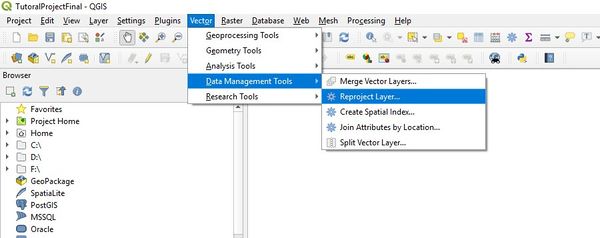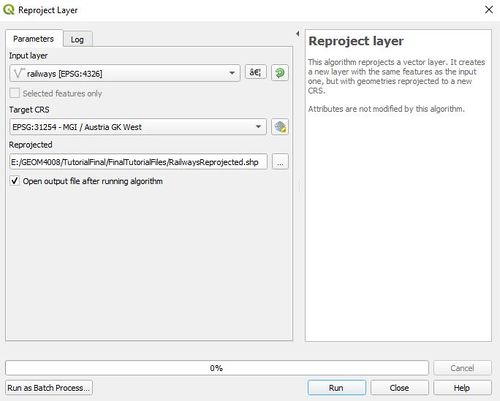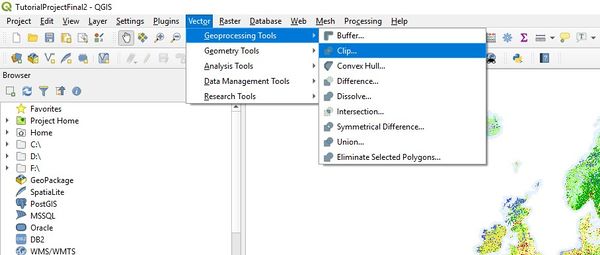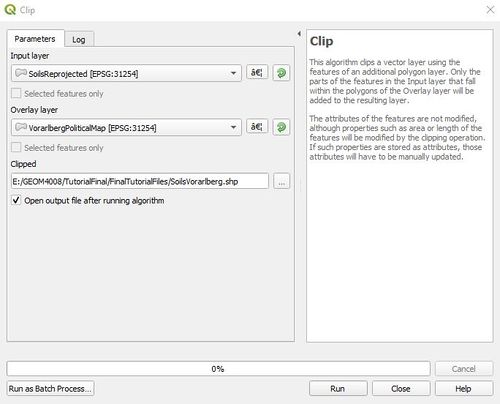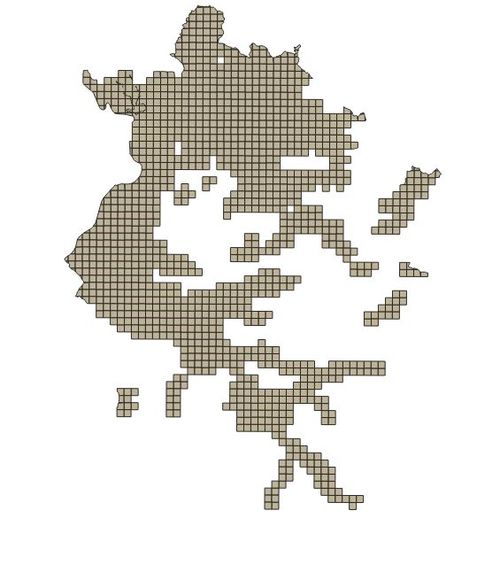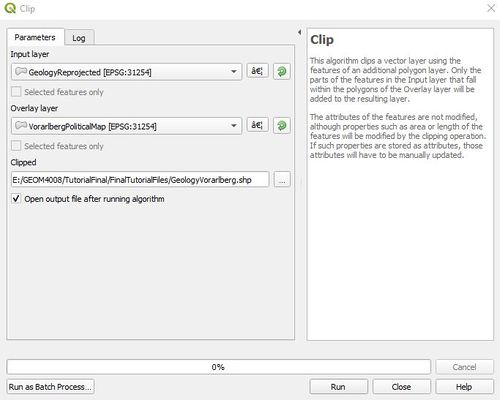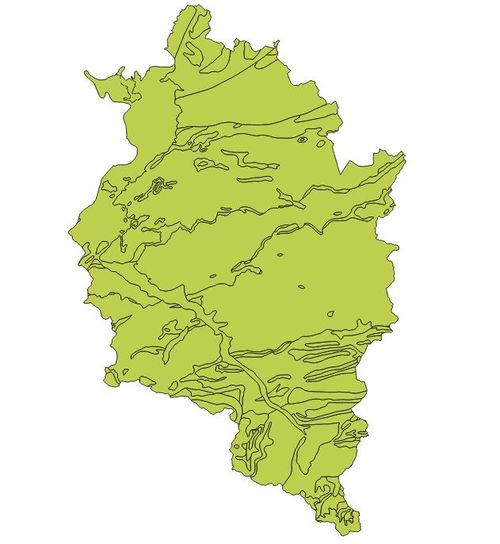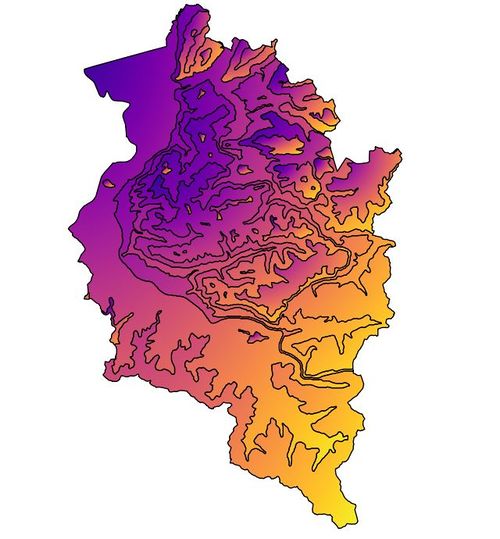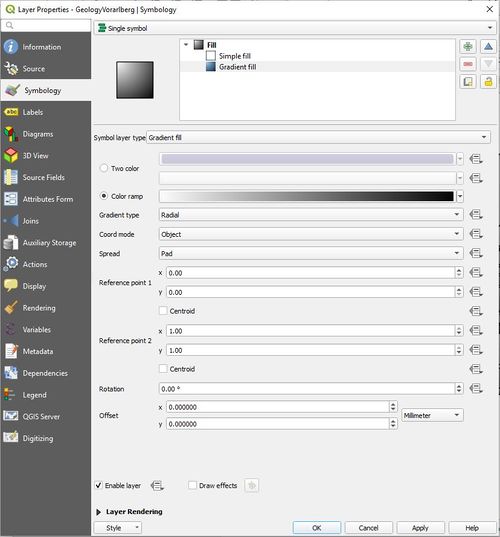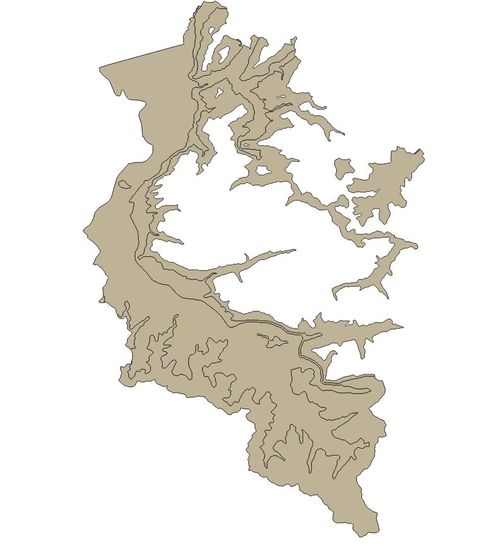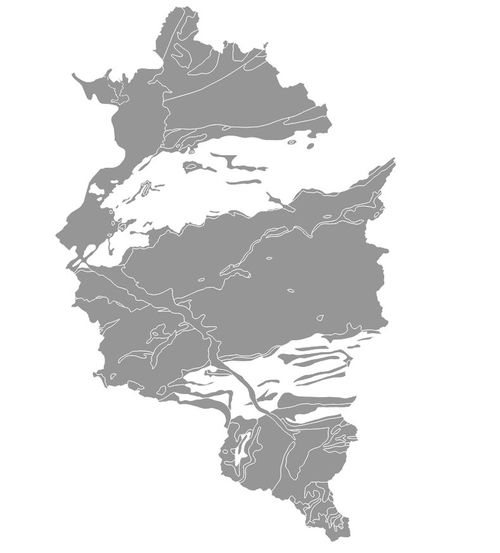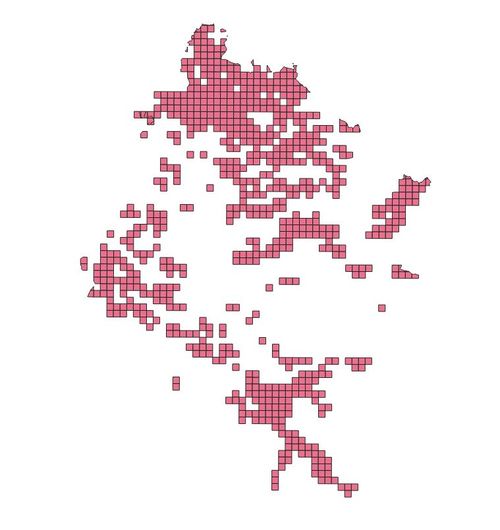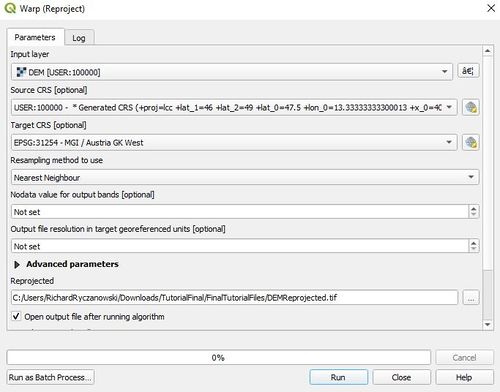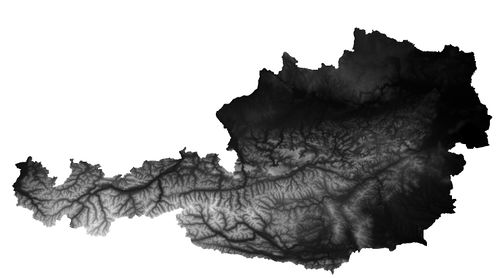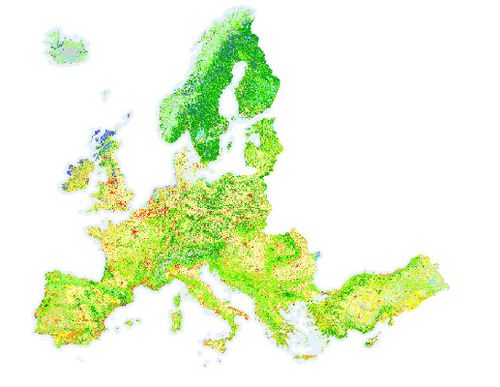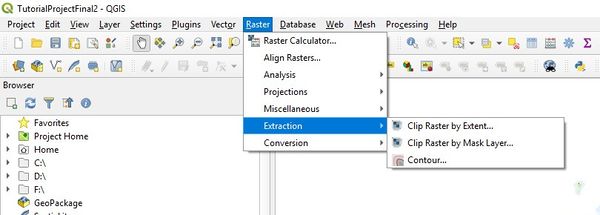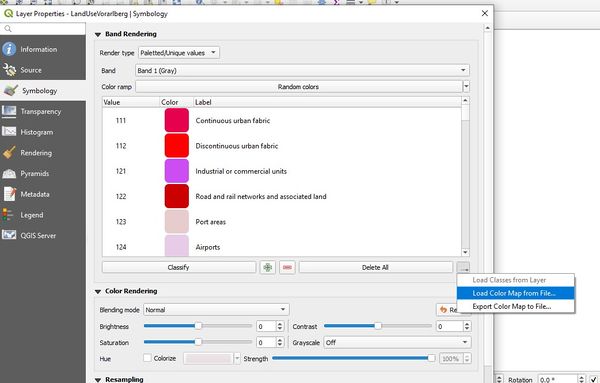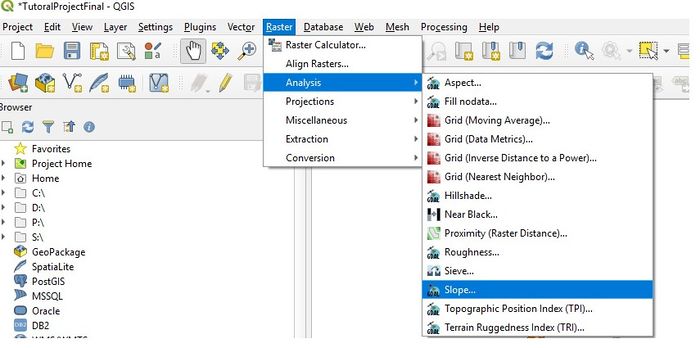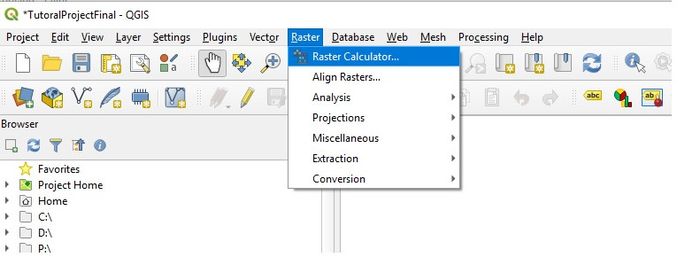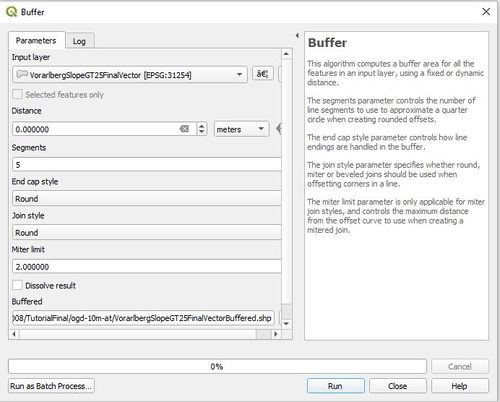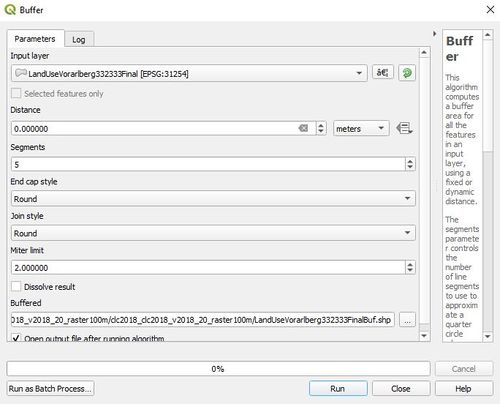Difference between revisions of "Hazardous Areas Around Linear Infrastructure"
| (180 intermediate revisions by the same user not shown) | |||
| Line 1: | Line 1: | ||
| − | = Introduction == |
+ | == Introduction == |
| + | Mountainous terrain can pose challenges for linear infrastructure such as railway lines and highways. Not only do such areas present operational challenges, they also face risks due to mass movements such as landslides, rock slides, and avalanches that can lead to physical damage, temporary closure, and even loss of life. Having information on potential locations for landslides and rock slides can be helpful in taking preventative action to reduce risks. Locations can be derived by examining the conditions that can make an area prone to such an event. Such conditions can include the landscape slope, soil type, rock type, precipitation levels, and land use. |
||
| − | Introduction |
||
| − | Mountainous terrain can pose challenges for linear infrastructure such as railway lines and highways. Not only do such areas present operational challenges, they also pose risks due to landslides, rockslides, and avalanches that can lead to physical damage, temporary closure, and even loss of life. Having information on potential locations for landslides and rockslides can be helpful in taking preventitive action to reduce risks. Locations can be derived by examining the conditions that can make an area prone to such an event. Such conditions can include the landscape slope, soil type, rock type, precipitation levels, and land use. |
||
| − | This tutorial will focus on railway infrastructure. It will do an analysis of a railway line in Western Austria known as the Vorarlberg Bahn that runs from Bludenz to Bregenz, the capital of Voralberg Land, with a connection to Switzerland. The line is a continuation of the Arlberg Bahn that runs from Innsbruck to Bludenz. It is 68 kilometres long and runs through the Walgau and Rhine valleys. It is owned and operated by the Austrian Federal Railways. |
+ | This tutorial will focus on railway infrastructure. It will do an analysis of a railway line in Western Austria known as the Vorarlberg Bahn that runs from Bludenz to Bregenz, the capital of Voralberg Land, with a connection to Switzerland. The line is a continuation of the Arlberg Bahn that runs from Innsbruck to Bludenz. It is 68 kilometres long and runs through the Walgau and Rhine valleys. It is owned and operated by the Austrian Federal Railways(ÖBB). |
== Objective == |
== Objective == |
||
| − | The objective of this analysis is to find locations along a section of railway infrastructure that are hazardous in that they could be areas prone to landslides or |
+ | The objective of this analysis is to find locations along a section of railway infrastructure that are hazardous in that they could be areas prone to mass movements such as landslides or rock slides. |
| − | == |
+ | ==Data and Software== |
| + | ===Data Layers=== |
||
| + | Data for this analysis came from various open data sources. A project folder should be set up for the project (e.g. titled RailInfrastrutureHazards) and the following data downloaded and unzipped into this folder. |
||
| − | |||
| − | |||
| − | ===Data Used=== |
||
| − | |||
| − | Data Sources |
||
| − | Data for this analysis came from various open data sources. A project folder should be set up for the project (e.g. titled RailInfrastruture) and the data downloaded and unzipped into this folder. |
||
*A map of the Austrian rail network can be found on the following GIS data site: |
*A map of the Austrian rail network can be found on the following GIS data site: |
||
Austria railway network: |
Austria railway network: |
||
https://mapcruzin.com/free-austria-arcgis-maps-shapefiles.htm |
https://mapcruzin.com/free-austria-arcgis-maps-shapefiles.htm |
||
| − | *A political map of Vorarlberg Land used to clip |
+ | *A political map of Vorarlberg Land used to clip vector and raster files from Land Vorarlberg: |
http://data.vorarlberg.gv.at/ogd/basisdaten/politische_gemeindegrenze.shtm |
http://data.vorarlberg.gv.at/ogd/basisdaten/politische_gemeindegrenze.shtm |
||
| − | *An annual rainfall shapefile for Vorarlberg |
+ | *An annual rainfall shapefile for Vorarlberg from Land Vorarlberg: |
http://data.vorarlberg.gv.at/ogd/geographieundplanung/jaehrliche_niederschlagss.shtm |
http://data.vorarlberg.gv.at/ogd/geographieundplanung/jaehrliche_niederschlagss.shtm |
||
| − | *A DEM raster file for Austria |
+ | *A DEM raster file for Austria from the Government of Austria through Open Data Osterreich: |
https://www.data.gv.at/katalog/dataset/b5de6975-417b-4320-afdb-eb2a9e2a1dbf |
https://www.data.gv.at/katalog/dataset/b5de6975-417b-4320-afdb-eb2a9e2a1dbf |
||
Click on “zur Ressource” to obtain file. |
Click on “zur Ressource” to obtain file. |
||
| − | *A geology shapefile of Austria |
+ | *A geology shapefile of Austria from the Geological Survey of Austria (GBA): |
https://www.geologie.ac.at/en/produkte-shop/geodaten-software/bersichtskarten/ |
https://www.geologie.ac.at/en/produkte-shop/geodaten-software/bersichtskarten/ |
||
| − | *A soil shapefile of Austria Austrian Research Centre for Forests (BFW): |
+ | *A soil shapefile of Austria from the Austrian Research Centre for Forests (BFW): |
https://bfw.ac.at/rz/bfwcms2.web?dok=8548 |
https://bfw.ac.at/rz/bfwcms2.web?dok=8548 |
||
| − | *A landcover/land use raster file of Europe |
+ | *A landcover/land use raster file of Europe from the Copernicus Land Monitoring Service: |
CLC_2018 Map |
CLC_2018 Map |
||
https://land.copernicus.eu/pan-european/corine-land-cover |
https://land.copernicus.eu/pan-european/corine-land-cover |
||
| Line 40: | Line 35: | ||
===Software Used=== |
===Software Used=== |
||
| − | The |
+ | The analysis is completed using the Quantum GIS 3.8.1 Zanzibar software interface. This is open source software material that are freely accessible and available online. For new users it is suggested to use the standalone installer. |
This is available by clicking this hyperlink. [http://www.qgis.org/en/site/forusers/download.html Click this!] |
This is available by clicking this hyperlink. [http://www.qgis.org/en/site/forusers/download.html Click this!] |
||
| + | |||
| + | ==Methods== |
||
===Starting Map Project=== |
===Starting Map Project=== |
||
| Line 50: | Line 47: | ||
===File Projections=== |
===File Projections=== |
||
| − | The map projection used for this analysis |
+ | The map projection used for this analysis is EPSG:31254-MGI/Austria GK West. |
| + | |||
| + | The initial file projections are as follows: |
||
| + | |||
| + | Vector Files: |
||
| − | The initial file projections were as follows: |
||
*Austrian rail network shapefile: EPSG:4326 -WGS 84 |
*Austrian rail network shapefile: EPSG:4326 -WGS 84 |
||
*Political shapefile of Vorarlberg: EPSG:31254 MGI/Austria GK West |
*Political shapefile of Vorarlberg: EPSG:31254 MGI/Austria GK West |
||
*Annual rainfall shapefile: 31254 MGI/Austria GK West |
*Annual rainfall shapefile: 31254 MGI/Austria GK West |
||
| − | *DEM Raster file:USER Generated CRS |
||
*Geology shapefile: 31287 – MGI Austria Lambert |
*Geology shapefile: 31287 – MGI Austria Lambert |
||
*Soil shapefile: EPSG:3035 – ETR89 |
*Soil shapefile: EPSG:3035 – ETR89 |
||
| + | |||
| + | |||
| + | Raster Files: |
||
| + | |||
| + | *DEM Raster file:USER Generated CRS |
||
*Land cover/land use raster file: EPSG:3035 -ETRS89/LAEA Europe |
*Land cover/land use raster file: EPSG:3035 -ETRS89/LAEA Europe |
||
| + | ===Processing of the Vector Files=== |
||
| − | The second step is to re-project the data. The following files had to be re-projected: Austrian rail network (vector), DEM (Raster), Geology (Vector), soil (Vector), and land cover/land use (Raster). |
||
| + | |||
'''Reprojection of Vector Files''' |
'''Reprojection of Vector Files''' |
||
| + | In order to prepare the vector files for use, they need to have the correct projection: EPSG:31254 MGI/Austria GK West. The "Political" and "Annual rainfall" vectors have the correct projection, so the three remaining vector layers need to be re-projected: Austrian rail network, Geology, and Soil. |
||
| − | To re-project the two vector files, select “Vector” from the top menu, then “Data Management Tools” and “Reproject Layer”. On the “Reproject Layer” window, select the layer to be re-projected as the “Input Layer” and the “Target CRS” as EPSG:31254-MGI/Austria GK West. The “Reprojected” box is used to setup the file for the re-projected layer. Press the “…” button, select “Save to File’, select the project folder and a file name for the re-projected file. The image below shows the “Reproject Layer” window for the vector files that need to be re-projected: |
||
| + | |||
| + | To re-project the three vector files, select “Vector” from the top menu, then “Data Management Tools” and “Reproject Layer”. |
||
| + | |||
| + | |||
| + | [[File:VectorReprojectTool.jpg|center|600px]] |
||
| + | |||
| + | |||
| + | On the “Reproject Layer” window, select the layer to be re-projected as the “Input Layer” and the “Target CRS” as EPSG:31254-MGI/Austria GK West. The “Reprojected” box is used to setup the file for the re-projected layer. Press the “…” button, select “Save to File’, select the project folder and a file name for the re-projected file. The image below shows the “Reproject Layer” window for the vector files that need to be re-projected: |
||
Re-projection Window |
Re-projection Window |
||
| Line 76: | Line 89: | ||
'''Clipping Vector Files to Area of Interest''' |
'''Clipping Vector Files to Area of Interest''' |
||
| − | The next step is to clip the vector files to the area of interest, Vorarlberg Land. The Annual Rainfall shapefile is already for Vorarlberg, so the “Railways”, “Geology” and “Soils” shapefiles need to be clipped. To clip these vector files, select “Vector” from the top menu, then “Geoprocessing Tools”, then “Clip”. |
+ | The next step is to clip the vector files to the area of interest, Vorarlberg Land. The Annual Rainfall shapefile is already for Vorarlberg, so the “Railways”, “Geology” and “Soils” shapefiles need to be clipped. To clip these vector files, select “Vector” from the top menu, then “Geoprocessing Tools”, then “Clip”. |
| + | [[File:VectorClipTool.jpg|center|600px]] |
||
| + | |||
| + | For the “Input layer”, select the file to be clipped (RailwayReprojected, SoilsReprojected or GeologyReprojected), then select the area of interest, Vorarlberg Political Map layer, as the “Overlay layer”. Under “Clipped”, select the “…” button, move to the folder where the project files are stored, and enter a name for the new layer under “File name”, seleck .shp for file type,and press “Save”. This must be done for the three vectors to be clipped. |
||
| − | Clip Window |
||
[[File:RailwaysClipped.JPG|500px]] |
[[File:RailwaysClipped.JPG|500px]] |
||
| + | [[File:RailwaysClippedPic.JPG|500px|Frameless|Caption]] |
||
| + | Railway lines in Vorarlberg Land |
||
| + | |||
[[File:SoilsClipped.JPG|500px]] |
[[File:SoilsClipped.JPG|500px]] |
||
| + | [[File:SoilsClippedPic.JPG|500px|frameless|caption]] |
||
| + | Soils in Vorarlberg Land |
||
| + | |||
[[File:GeologyClipped.JPG|500px]] |
[[File:GeologyClipped.JPG|500px]] |
||
| + | [[File:GeologyClippedPic.JPG|500px|frameless|caption]] |
||
| + | Geology in Vorarlberg Land |
||
| + | In order to find hazardous areas of concern around the rail lines, a buffer of 1000 metres was established on either side of the line. To do this, select "vector" from the top menu, then "Geoprocessing Tools" and then "Buffer". |
||
| − | The Resulting Layers: |
||
| − | [[File: |
+ | [[File:BufferRailwaysToolWindow.jpg|600px|center]] |
| − | [[File:SoilsClippedPic.JPG|500px]] |
||
| − | [[File:GeologyClippedPic.JPG|500px]] |
||
| + | In the Buffer window, select the RailwaysVorarlberg file as the "Input Layer", set 1000 meters under "Distance", and check off the "Dissolved result" checkbox. Leave all other parameters as default. Under "Buffered", press the ... button and select 'Save to File...". Select an appropriate filename for the buffered rail file, select .shp for the file type, and save in the appropriate directory by |
||
| − | The next step is to change the colour scheme of two of the vector layers to bring out the contrasting data within the layer. The AnnualRainfallVorarlberg and GeologyVorarlberg layers will need to have their colours adjusted. To do this, highlight and right click on the layer in the “Layer Box” of the main project page, select “Properties”, and then “Symbology”. For the AnnualRainfallVorarlberg layer, select “gradient plasma” under the Favorites Box. Select “Apply” and then “Okay”. For the GeologyVorarlberg layer, complete the same procedure then select “Gradient Fill” in the top box and select “Grey” under the “color ramp”. Select “Apply” and then “Okay”. |
||
| + | [[File:RailwaysBufferWindow.JPG|500px]] |
||
| + | [[File:RailwaysBufferLayer.JPG|500px|frameless|caption]] |
||
| + | Railways lines in Vorarlberg with 1000 metre buffer on both sides. |
||
| + | |||
| − | Symbology Windows |
||
| + | The next step is to change the colour scheme of two of the vector layers to bring out the contrasting data within the layer. The AnnualRainfallVorarlberg and GeologyVorarlberg layers will need to have their colours adjusted. To do this, highlight and right click on the layer in the “Layer Box” of the main project page, select “Properties”, and then “Symbology”. For the AnnualRainfallVorarlberg layer, select “gradient plasma” under the Favorites Box. Select “Apply” and then “Okay”. For the GeologyVorarlberg layer, complete the same procedure then select “Gradient Fill” in the top box and select “Grey” under the “color ramp”. Select “Apply” and then “Okay”. |
||
[[File:SymbologyRainfall.JPG|500px]] |
[[File:SymbologyRainfall.JPG|500px]] |
||
| + | [[File:RainfallLayerColor.JPG|500px|frameless|caption]] |
||
| + | Rainfall with new symbology. |
||
| + | |||
[[File:SymbologyGeology.JPG|500px]] |
[[File:SymbologyGeology.JPG|500px]] |
||
| + | [[File:GeologyLayerColor.JPG|500px|frameless|caption]] |
||
| + | Geology with new symbology |
||
| − | The Resulting Layers |
||
| + | '''Selection of Potentially Hazardous Areas''' |
||
| − | [[File:RainfallLayerColor.JPG|500px]] |
||
| − | [[File:GeologyLayerColor.JPG|500px]] |
||
| − | For each vector |
+ | For each of the vector layers that define the characteristics of the Vorarlberg region, the attributes of interest that define hazardous areas must be selected. For AnnualRainfallVorarlberg, the rainfall is grouped in intervals between 1500 and 3000 mm , so the lowest three intervals were chosen: 1200-1500 mm, 1500-1800 mm and 1800-2100 mm. For GeologyVorarlberg layer, the rock types of interest were phylites, schists and sediments. For the SoilsVorarlberg layer, the soils of interest were clays (Lehm in German) and sand (Sand in German). |
To select by attributes, the layer must be highlighted and right clicked in the main layer box and “Open Attribute Table” selected. Along the top of the attribute table are the headings for each column with the data in the columns below. From here, the “Select features using expression” button [[File:SelectbyAttributesButton.JPG|25px]] opens the “Select by expression” box (see below). The following expressions are entered in the left had expression box: |
To select by attributes, the layer must be highlighted and right clicked in the main layer box and “Open Attribute Table” selected. Along the top of the attribute table are the headings for each column with the data in the columns below. From here, the “Select features using expression” button [[File:SelectbyAttributesButton.JPG|25px]] opens the “Select by expression” box (see below). The following expressions are entered in the left had expression box: |
||
| Line 113: | Line 141: | ||
After entering the above equation in the “ Select by Expression” box, press “Select Features” at the bottom of the window and the selected features will be highlighted in the attribute table and map layer. |
After entering the above equation in the “ Select by Expression” box, press “Select Features” at the bottom of the window and the selected features will be highlighted in the attribute table and map layer. |
||
| − | |||
| − | |||
| − | Select By Attributes Windows |
||
[[File:SelectByAttributesRainfall.JPG|520px]] |
[[File:SelectByAttributesRainfall.JPG|520px]] |
||
| + | [[File:AnnualRainfallSelect.JPG|500px|frameless|caption]] |
||
| + | Areas in Voarlberg with annual rainfall of 1200-1500 mm, 1500-1800 mm and 1800-2100 mm (yellow). |
||
| + | |||
[[File:SelectByAttributesGeology.JPG|520px]] |
[[File:SelectByAttributesGeology.JPG|520px]] |
||
| + | [[File:GeologyVorarlbergSelect.JPG|500px|frameless|caption]] |
||
| + | Areas in Vorarlberg with the following geological structures: phylite, schist or sediment(yellow). |
||
| + | |||
[[File:SelectByAttributesSoils.JPG|600px]] |
[[File:SelectByAttributesSoils.JPG|600px]] |
||
| + | [[File:SoilsVorarlbergSelect.JPG|500px|frameless|caption]] |
||
| + | Areas in Vorarlberg with clay or sandy soil (yellow). |
||
| + | The next step is to save the selected attributes for each layer as a separate layer. Highlight the layer in the layer window, right click on it, select “Export” and “Save selected features as”. In the “Save Vector Layer as” window, set the “Format” to ESRI Shapefile, use the … button to select the project directory and give the layer a file name, and check the “Save only selected features” box. The CRS should be set to EPSG:31254 MGI/Austria GK West. |
||
| + | [[File:RainfallHazard.JPG|500px|frameless|caption]] |
||
| − | The resulting layers |
||
| + | Rainfall |
||
| + | [[File:GeologyHazard.JPG|500px|frameless|caption]] |
||
| + | Geology |
||
| + | [[File:SoilsHazard.JPG|500px|frameless|caption]] |
||
| + | Soils |
||
| − | [[File:AnnualRainfallSelect.JPG|500px]] |
||
| − | [[File:GeologyVorarlbergSelect.JPG|500px]] |
||
| − | [[File:SoilsVorarlbergSelect.JPG|500px]] |
||
| + | These three layers define areas of rainfall, geology and soils in Vorarlberg Land that could be potentially hazardous for linear infrastructure. |
||
| − | The next step is to save the selected attributes for each layer as a separate layer. Highlight the layer in the layer window, right click on it, select “export” and “Save selected features as”. In the “Save Vector Layer as” window, set the “Format” to ESRI Shapefile, use the … button to select the project directory and give the layer a file name, and check the “Save only selected features” box. The CRS should be set to EPSG:31254 MGI/Austria GK West. |
||
| + | ===Processing of the Raster Files=== |
||
| − | The resulting layers |
||
| + | In order to use the raster files, they need to have the correct projection. Both the DEM and Land Use layers have to be reprojected to EPSG:31254-MGI/Austria GK West . In order to do this for each layer,"Raster" must be selected from the top menu, "Projections" from the drop down menu, and then "Warp (Reproject)" selected. |
||
| − | [[File:RainfallHazard.JPG|500px]] |
||
| − | [[File:GeologyHazard.JPG|500px]] |
||
| − | [[File:SoilsHazard.JPG|500px]] |
||
| + | [[File:RasterReprojectTool.jpg|center|700px]] |
||
| − | [[File:AustriaDEMPic.JPG|500px]] |
||
| − | [[File:LandUsePic.JPG|500px]] |
||
| + | On the "Warp (Reproject)" window, select the original vector file as the "Input Layer", select EPSG:31254-MGI/Austria GK West as the "Target CRS" and define a new file for the output under "Reprojected". Leave all other parameters at the default settings. Pressing "Run" will start the reprojection process. |
||
| − | [[ |
+ | [[File:DEMReprojectWindow.JPG|500px]] |
| − | [[ |
+ | [[File:AustriaDEMPic.JPG|500px|frameless|caption]] |
| + | DEM |
||
| + | [[File:LandUseReprojectWindow.JPG|500px]] |
||
| + | [[File:LandUsePic.JPG|500px|frameless|caption]] |
||
| + | Land Use |
||
| + | The raster layers must then be clipped to the extent of Vorarlberg Land. To accomplish this, "Raster" must be selected from the top menu and "Extraction" from the drop down menu. |
||
| + | [[File:RasterClipTool.jpg|center|600px]] |
||
| + | For the Reprojected DEM file, "Clip Raster by Mask Layer" should the be selected. The "Input layer" is the DEMReprojected raster layer, and the "Mask Layer" is the Vorarlberg Political Map layer. Under "Advanced Parameters", a new file is defined for the clipped DEM layer under "Clipped (mask)"in an appropriate file directory. |
||
| − | # Next the vector files must be clipped to fit within the extent of the Ottawa area. If all your data fit within the boundaries of Ottawa, skip this step. |
||
| − | ## Select the 'Vector' tab at the top, the 'Geoprocessing' menu and select the Clip tool. |
||
| − | ## In the 'Input layer' section select the layers that need to be clipped down. Do this individually for each layer that needs to be clipped. |
||
| − | ## In the 'Clip layer' section select the layer that will act as your extent, the Wards layer. |
||
| − | ## The next section is for specifying your output. Click the 3-dot button and and select save to file. Name your new file with details (example: TransmissionLinesUTMClipped), and save click save in that new window. |
||
| − | ## Make sure the box under the output section is checked to allow the program to automatically add it to your working layers. [[File:clip.JPG]] |
||
| − | # If the clipping tool has a blank output and you get a warning message that the CRS do not align and will cause problems, this is the solution to that problem (skip if the clipping worked): |
||
| − | ## Click the CRS button on the bottom toolbar of the program, beside the speech bubble. At the top of that popup, you want to enable the 'On the fly' transformation, if it is not enabled already. |
||
| − | ## From here, select the layer in the Layers Panel that is not aligning with your desired CRS, and right click it. From this menu select the 'save as' option and create the same shapefile with a new name, and with the CRS of the project. This creates the shapefile again, but this time with the CRS aligning with the project, and allowing you to work with the layers using geoprocessing tools. |
||
| − | #If your layer has a geometry error that prevents clipping (the Water and Wooden Area layer has this problem), the solution to this problem is to create a buffer for the layer with a value of zero. This can be accomplished by selecting the "Vector" from the top menu, the "Geoprocessing" tools from the drop down menu, and then selecting "Buffer". For the input layer, select the layer with the geometry problem that needs to be buffered, and set the Distance at 0 metres. Under "Buffered", click the 3-dot button and and select save to file. Name your new file with details (example: WaterZeroBuffer) and click "Run" in that new window. The buffered layer should then appear in your layer list. It should be renamed accordingly by right clicking on the layer, selecting properties, selecting "source" from the side menu, and changing the layer name in the "Layer Name" box. |
||
| + | For the Land Use layer, "Raster" is selected from the top menu, then "Extraction" from the drop down menu, then "Clip Raster by Extent". On the Clip Raster by Extent window, the LandUseReprojected raster file is selected for "Input Layer" and the Vorarlbeg Political Map layer as the clipping extent. This is done by pressing the small...button at the end of the "Clipping extent (xmin,xmax,ymin, ymax) option, then selecting "Use Layer Extent" and then selecting VorarlbergPoliticalMap under "Use extent from". Under "Advanced Parameters" name a new file for the clipped Land Use raster in an appropriate file directory. |
||
| − | ===Narrowing Results to a Specific Delineation Area=== |
||
| − | This section focuses on narrowing the view to a specific area of interest. In this case the area of interest is Ward 21, Rideau-Goulbourn. This is a largely rural/agricultural ward of the city, making it a prospective optimal area for the production of wind energy. This process will involve the exporting of the specified area as a new shapefile. |
||
| + | [[File:DEMClipRasterWindow.JPG|500px]] |
||
| + | [[File:DEMVorarlbergPic.JPG|500px|frameless|caption]] |
||
| + | DEM layer clipped to Vorarlberg area. |
||
| + | [[File:LandUseClipWindow.JPG|500px]] |
||
| − | ## Input the data you want to cut down and show them instead of the full extent shapefiles. |
||
| + | [[File:LandUseVoralbergPic.JPG|500px|frameless|caption]] |
||
| + | Land use layer clipped to the extent of Vorarlberg area. |
||
| + | To identify the land use/cover classes in the land use layer, the legend will have to be added to the layer. The legend can be found in the "Legend"directory of the unzipped land use data. To add the legend, select the LandUseVorarlberg layer in the "Layers" window of the main page, right click on it, select "Properties", then select "Symbology", |
||
| − | ===Visualization of Restrictions using a Buffer=== |
||
| + | [[File:AddLegend.jpg|center|600px]] |
||
| − | This section will demonstrate how to add a buffer region to each of the vector layers representing the limitations imposed by the spatial restrictions set by the Government of Ontario. |
||
| − | # Open the "Vector" tab and go to the "Geoprocessing" menu, and select the "Buffer" tool |
||
| − | # To create the railway buffer, select the Railway Lines layer under the 'Input layer' field |
||
| − | ## Set the 'Distance' field to 135 (this number represents the 135m restriction applied to Railways) |
||
| − | ## Leave 'Segment' as the default 5, as changing this does not have a significant impact on the end result. |
||
| − | ## Make sure the dissolve box is checked, which makes the buffer a continuous shape, instead of separate entities. |
||
| − | ## Click the 3-dot button and and select save to file, name your new file with details (example: RailwayLinesUTMClippedBuffer135m), and click save in that new window. |
||
| − | ## Click Run, and wait for the output to successfully finish (this may take an extended period of time depending on the size of the input vector layer |
||
| − | #[[File:BufferTool.JPG]] |
||
| − | # Complete this process for Road Layers, again setting the 'Distance' to 135 as the restriction for roads is the same as railways. |
||
| − | # When completing this process for the Transmission Lines layer, make sure to change the 'Distance' parameter to 1000 to meet the 1000m restriction imposed on this infrastructure. |
||
| − | # For both "Water" and "Wooded Area", make sure to change the "Distance" parameter to 120 metres to meet the 120 m restriction imposed on these areas. |
||
| + | Look for the small button to the right of the "Delete All" button. Press the button, select "Load colour map from file", and add the CLC2018+CLC2018_V2018_20_QGIS text file from the "Legend" directory of the unzipped land use data. This will add the legend information under the land use layer in the main "Layer"window. |
||
| − | '''Representation of the Resulting Layers:''' |
||
| − | [[File:RailwaysBuffer.JPG|500px]] |
||
| − | [[File:RoadsBuffer.JPG|500px]] |
||
| − | [[File:TransmissionLineBuffer.JPG|500px]] |
||
| − | [[File:WaterBuffer.JPG|500px]] |
||
| − | [[File:WoodedAreaBuffer.JPG|500px]] |
||
| + | In order to find areas with hazardous slopes, the DEM layer will have to be converted into a slope layer. To do this, "Raster" is selected from the top menu, then "Analysis" from the drop down menu, then "Slope". |
||
| − | ===Creation of Total Suitable Areas Using an Overlay=== |
||
| + | [[File:RasterSlopeTool.jpg|center|700px]] |
||
| − | This section will demonstrate the use of vector overlay techniques in order to visualize the suitable areas for wind turbines that are free of spatial restrictions. |
||
| + | The DEM Vorarlberg layer is selected as the "Input layer" and under "Advance Parameters" and "Slope" specify a filename for the new slope layer in the appropriate project directory. Leave all other parameters at their default settings. |
||
| − | Using Union to Create a Merged Buffer Layer |
||
| + | |||
| + | [[File:SlopeVorarlberg.JPG|500px]] |
||
| − | # Select the 'Vector' tab, select 'Geoprocessing tools' and select 'Union' as the last part of the menu. |
||
| + | [[File:SlopeVorarlbergPic.JPG|500px|frameless|caption]] |
||
| − | ## Under the 'input layer' field choose the Railway Buffer layer. |
||
| + | Slope layer for Vorarlberg area. |
||
| − | ## Under the 'input layer 2' field choose the Transmission Lines Buffer layer. |
||
| − | ## Under the 'Union' field provide an output name (example: RailwayTransmissionLinesUnion) |
||
| − | ## Click run, and wait for the output to successfully finish. [[File:UnionTool.JPG]] |
||
| − | # Return to the 'Union' tool. |
||
| − | ## Under the 'Input layer' field choose the Union layer just created (example: RailwayTransmissionLinesUnion). |
||
| − | ## Under the 'Input layer 2' field choose the Roads Buffer layer. |
||
| − | ## Under the 'Union' field provide an output name (example: RailwayTransmissionLinesRoadsUnion) |
||
| − | ## Click run, and wait for the output to successfully finish. |
||
| − | ## Repeat the same process for Water and Wooded Area to add these two buffered areas to the "Union" layer thus creating two more union layers (RailwayTransmissionLinesRoadsWaterUnion and RailwayTransmissionLinesRoadsWaterWoodedAreaUnion). The latter layer is the final merge layer incorporating all five buffers. |
||
| + | The next step is to identify those areas of slope and land use/cover that could be potentially hazardous. For the slope, those above 25 degrees are considered to be potentially hazardous. For land use/cover, potentially hazardous areas are bare rock (332) or sparsely vegetated land (333). In order to select these area from the relevant raster layer, the raster calculator will be used. The Raster Calculator can be found under "Raster" on the main menu at the top. |
||
| − | Using Dissolve to Clean Up the Final Merged Buffer Layer |
||
| + | [[File:RasterCalculatorTool.jpg|center|700px]] |
||
| − | # Return to the 'Geoprocessing tools' tab and select the tool 'Dissolve'. This will clean up the merged layers. |
||
| − | ## Select the shapefile you just created as the final merge, and check the box 'Dissolve All'. |
||
| − | This process results in the overlay of all five buffer restriction layers providing a total suitability layer which considers all restrictions. |
||
| + | On the raster Calculator window for the slope layer, under "Raster Bands" select the SlopeVorarlberg layer. Under "Output Layer", select a name for the new layer file for the selected areas in the appropriate directory. In the "Raster Calculator Expression" window, double click on the SlopeVorarlberg layer in the "Raster Bands" box and the operator buttons to enter the following equation: |
||
| − | '''Representation of the Resulting Layer:''' |
||
| + | "SlopeVorarlberg@1" > 25 |
||
| − | [[File:FinalUnion.JPG|400pix]] [[File:FinalUnionDissolved.JPG|400pix]] |
||
| + | Then press okay to start the selection operation. |
||
| − | ===Identifying Largest Suitable Area=== |
||
| + | For the Land Use layer, under "Raster Bands" in the "Raster Calculator" window, select the LandUseVorarlberg layer. Under "Output Layer", select a name for the new layer file for the selected areas in the appropriate directory. In the "Raster Calculator Expression" window, use double clicks on the LandUseVorarlberg layer in the "Raster Bands" box and the operator buttons to enter the following equation: |
||
| − | The Largest suitable area can be identified using the 'measurement tool' located on the toolbar. However, this would take a lot of time to outline each shape, so I will show you a way to calculate each area. |
||
| − | # The first step is to go 'Vector'>'Geoprocessing'> 'Difference'. |
||
| − | ## Select the extent area as the input and the merged buffers as the difference. |
||
| − | # You now can see each individual shape away from the buffers, which allows us to calculate the area of each shape. |
||
| − | ## First we must separate them in the attribute table, and to do this we must create another shapefile. To do this go 'Vector'>'Geometry'> 'Multiparts to Singleparts'. |
||
| − | ## Select the created shapefile from the 'Difference' tool and create a new shapefile of separated features. |
||
| − | # Now turn on editing of this new shapefile, and open the attribute table to reveal the large number of features present in this shapefile. |
||
| − | ## You can turn on editing by right-clicking the layer in the Layer Panel and selecting the 'Toggle Editing' option. |
||
| − | ## Once in the attribute table create a new field. You will want to name the field "area" and select 'Decimal Number'. Precision and Length can be left default. |
||
| − | ## Now open the 'Field Calculator' and select 'Update existing field' and select the field you created. |
||
| − | ## In the search bar below, type in "area" and select the option named "$area" |
||
| − | ## press 'OK' and all shapes will have an updated area field in meters squared. Sort the new field to find the largest in terms of area. [[File:FieldCalculator.JPG]] |
||
| − | #Once the largest suitable area has been identified, create a new vector polygon to represent this area. This can be done with the same process that was used to create the Ward 21 polygon from the Wards layer. |
||
| + | "LandUseVorarlberg@1" = 332 OR "LandUseVorarlberg@1" = 333 |
||
| − | '''Representation of the Resulting Layer:''' |
||
| + | Then press okay to start the selection operation. |
||
| − | [[File:LargestSiteWard21.JPG]] |
||
| + | |||
| + | [[File:SlopeRasterCalculator.JPG|500px]] |
||
| − | The resulting layer provides the largest suitable area for the specific region of interest with the consideration of all implied restrictions. By combining all the final layers together, you would get a map that shows the most suitable locations for wind turbines, along with the provincial restrictions set in place. |
||
| + | [[File:SlopeGT25Layer.JPG|500px|frameless|caption]] |
||
| − | This process can be used for any of the wards in the Ottawa region, and it could be used to select different areas with different restrictions, all depending on the data present. |
||
| + | Layer with slope greater than 25 degrees |
||
| + | [[File:RasterCalculatorLandUseWindow.JPG|500px]] |
||
| − | ''' Final output map ''' |
||
| + | [[File:SlopeRasterCalResult.JPG|500px|frameless|caption]] |
||
| + | Layer with bare rock or sparsely vegetated land use/cover. |
||
| + | In both layers, the white areas are the ones that are potentially hazardous. |
||
| − | [[File:FinalMap.JPG]] |
||
| + | In order to further utilize the slope and land use raster layers with the selected areas, they must be converted into vector layers. To do this, the procedure is the same for both layers. Select "Raster" on the main menu at the top, then "Conversion" on the drop down menu, then "Polygonize (Raster to Vector)'. For the SlopeVorarlbergGT25 layer, select that file as the "Input layer", then, under "Vectorized", input a file name for the new VorarlbergSlopeGT25 layer in the appropriate project directory. Press Run to start the conversion process. The process is the same for the Land Use layer. |
||
| − | ==References== |
||
| + | [[File:VorarlbergSlopeGT25VectorWindow.JPG|500px]] |
||
| − | * Energy Ottawa. (2010). "Green Power". Accessed online: http://www.energyottawa.com/forms/index.cfm?dsp=template&act=view3&template_id=46&lang=e |
||
| + | [[File:SlopeGT25VectorLayer.JPG|500px|frameless|caption]] |
||
| − | * Ministry of the Environment, Conservation and Parks. "Location/site considerations checklist for renewable energy projects" Accessed online: https://www.ontario.ca/page/locationsite-considerations-checklist-renewable-energy-projects |
||
| + | Vector layer for slope greater than 25 degrees. |
||
| − | * Natural Resources Canada. (2009). “Hydroelectric Generation”. The Atlas of Canada. Accessed online:http://atlas.nrcan.gc.ca/auth/english/maps/freshwater/consumption/hydroelectric/1 |
||
| + | |||
| + | [[File:LandUseVectorizeWindow.JPG|500px]] |
||
| + | [[File:LandUse332333VectorLayer.JPG|500px|frameless|caption]] |
||
| + | Vector layer for bare rock and sparsely vegetated land use/cover. |
||
| + | |||
| + | |||
| + | Unfortunately, the vectored layer output for both layers have an invalid geometry. To correct this problem, and make the layers usable for the rest of the analysis, a new vector layer must be created for each original layer with a buffer of zero. The procedure to do this for both layers is the same. Select "Vector" from the main menu at the top, then "Geoprocessing tools" and then "Buffer". For the slope vector, select the SlopeVoralbergGT25FinalVector layer as the "Input layer" in the Buffer window, set the "Distance" to zero, and select a file name and directory for the new SlopeGT25VectorBuffered layer under "Buffered" and place in the appropriate directory. Leave all the other settings at their default. Press Run to start the buffering process. The procedure is the same for the land use layer using the LandUse332333 vector file. |
||
| + | |||
| + | |||
| + | [[File:BufferFinal VorarlbergSlopeGT25.JPG|500px]] |
||
| + | [[File:BufferLandUseWindow.JPG|500px]] |
||
| + | |||
| + | |||
| + | |||
| + | |||
| + | |||
| + | |||
| + | |||
| + | |||
| + | |||
| + | |||
| + | |||
| + | |||
| + | |||
| + | |||
| + | ===Intersecting the Layers=== |
||
| + | |||
| + | The final stage of this analysis is to intersect the five layers that have been used to define potentially hazardous areas (based on Annual Rainfall, Geology, Soils, Land Use and Slope)to determine the final area where the characteristics combine to make the area a combined hazardous area. To do this, a series of intersection operations are performed: |
||
| + | |||
| + | Annual Rainfall intersects with Geology to give AnnualRainfallGeologyIntersection |
||
| + | AnnualRainfallGeology intersects with Soils to give AnnualRainfallGeologySoilsIntersection |
||
| + | AnnualRainfallGeologySoils intersects with Land Use to give AnnualRainfallGeologySoilsLandUseIntersection |
||
| + | AnnualRainfallGeologySoilsLandUse intersects with Slope to give AnnualRainfallGeologySoilsLandUseSlopeIntersection |
||
| + | |||
| + | To give the final combined hazardous areas within the 1000 metre railway buffer: |
||
| + | |||
| + | AnnualRainfallGeologySoilsLandUseSlope intersects with Rail Buffer to give AnnualRainfallGeologySoilsLandUseSlopeRailBufferIntersection |
||
| + | |||
| + | To create the intersection layers, select "Vector" from the top menu, then "Geoprocessing Tools" and then "Intersection". |
||
| + | |||
| + | [[File:VectorIntersectionTool.jpg|centre|700px]] |
||
| + | |||
| + | |||
| + | |||
| + | In the intersection window, under "Input Layer" select the first of the two layers that are to be intersected. In the "Overlay layer", select the second layer that is to be intersected. Under "Advanced Parameters", a new filename is entered for the new intersection file that is saved in the appropriate project directory. Leave all other options at their default settings. Pressing "Run" starts the intersection process. The Intersection Window for each of the five intersections are shown below with their output layers. |
||
| + | |||
| + | |||
| + | |||
| + | [[File:AnnualRainfallGeologyIntersection.JPG|450px]] |
||
| + | [[File:RainfallGeologyIntersectionImage.JPG|450px|frameless|caption]] |
||
| + | Rainfall and Geology Intersection Layer |
||
| + | |||
| + | [[File:AnnualRainfallGeologySoilsIntersectionImage.JPG|450px]] |
||
| + | [[File:RainfallGeologySoilsIntersectionLayerImage.JPG|450px|frameless|Caption]] |
||
| + | Rainfall-Geology and Soils Intersection Layer |
||
| + | |||
| + | [[File:RainfallGeologySoilsLandUseIntersectionWindow.JPG|450px]] |
||
| + | [[File:RainfallGeologySoilsLandUseIntersectionLayer.JPG|450px|frameless|caption]] |
||
| + | Rainfall-Geology-Soils and Land Use Intersection Layer |
||
| + | |||
| + | [[File:RainfallGeologySoilsLandUseSlopeIntersection.JPG|450px]] |
||
| + | [[File:RainfallGeologySoilsLandUseSlopeIntersectionLayer.JPG|450px|frameles|caption]] |
||
| + | Rainfall-Geology-Soils-Landuse and Slope Intersection Layer |
||
| + | |||
| + | [[File:RainfallGeologySoilsLandUseSlopeRailBufferIntersectionWindow.JPG|450px]] |
||
| + | [[File:RainfallGeologySoilsLandUseSlopeRailBufferIntersectionLayer.JPG|450px|frameless|caption]] |
||
| + | Rainfall-Geology-Soils-Landuse-Slope and Rail Buffer Intersection Layer |
||
| + | |||
| + | ===Final Maps=== |
||
| + | |||
| + | Here are the final maps showing the hazardous areas of concern for mass movements along railway lines in Vorarlberg region. These are areas where mean annual rainfall, soils, geology,land use and slope with characteristics that are prone to mass movements overlap. |
||
| + | |||
| + | [[File:HazardousAreasMap.JPG|500px|frameless|Caption]] |
||
| + | Map of Vorarlberg showing hazardous areas along rail line |
||
| + | |||
| + | [[File:HazardousAreasZoom.JPG|500px|frameless|caption]] |
||
| + | Zoomed in map of hazardous areas. |
||
| + | |||
| + | |||
| + | ==References== |
||
| + | Laimer. H. 2017. Anthropogenically induced landslides – A challenge for railway infrastructure in mountainous regions. Engineering Geology. 222:92-101. |
||
| + | |||
| + | Peruccacci, S., M. Brunetti, S. Gariano, M. Melillo, M. Rossi, and F. Guzzetti (2017). Rainfall thresholds for possible landslide occurrence in Italy. Geomorphology 290: 39-57. |
||
| + | Rachoy C. and M. Scheikl (2006). Anthropogenic caused mass movements and their impact on railway lines in Austria. Pages 639 – 643 in H. Mauri and M. Mikos, editors. Disaster mitigation of debris flow, slope failures and landslides. Universal Academy Press, Tokyo, Japan. |
||
| − | [[Category:Tutorials]] |
||
Latest revision as of 00:02, 22 December 2019
Contents
Introduction
Mountainous terrain can pose challenges for linear infrastructure such as railway lines and highways. Not only do such areas present operational challenges, they also face risks due to mass movements such as landslides, rock slides, and avalanches that can lead to physical damage, temporary closure, and even loss of life. Having information on potential locations for landslides and rock slides can be helpful in taking preventative action to reduce risks. Locations can be derived by examining the conditions that can make an area prone to such an event. Such conditions can include the landscape slope, soil type, rock type, precipitation levels, and land use.
This tutorial will focus on railway infrastructure. It will do an analysis of a railway line in Western Austria known as the Vorarlberg Bahn that runs from Bludenz to Bregenz, the capital of Voralberg Land, with a connection to Switzerland. The line is a continuation of the Arlberg Bahn that runs from Innsbruck to Bludenz. It is 68 kilometres long and runs through the Walgau and Rhine valleys. It is owned and operated by the Austrian Federal Railways(ÖBB).
Objective
The objective of this analysis is to find locations along a section of railway infrastructure that are hazardous in that they could be areas prone to mass movements such as landslides or rock slides.
Data and Software
Data Layers
Data for this analysis came from various open data sources. A project folder should be set up for the project (e.g. titled RailInfrastrutureHazards) and the following data downloaded and unzipped into this folder.
- A map of the Austrian rail network can be found on the following GIS data site:
Austria railway network: https://mapcruzin.com/free-austria-arcgis-maps-shapefiles.htm
- A political map of Vorarlberg Land used to clip vector and raster files from Land Vorarlberg:
http://data.vorarlberg.gv.at/ogd/basisdaten/politische_gemeindegrenze.shtm
- An annual rainfall shapefile for Vorarlberg from Land Vorarlberg:
http://data.vorarlberg.gv.at/ogd/geographieundplanung/jaehrliche_niederschlagss.shtm
- A DEM raster file for Austria from the Government of Austria through Open Data Osterreich:
https://www.data.gv.at/katalog/dataset/b5de6975-417b-4320-afdb-eb2a9e2a1dbf Click on “zur Ressource” to obtain file.
- A geology shapefile of Austria from the Geological Survey of Austria (GBA):
https://www.geologie.ac.at/en/produkte-shop/geodaten-software/bersichtskarten/
- A soil shapefile of Austria from the Austrian Research Centre for Forests (BFW):
https://bfw.ac.at/rz/bfwcms2.web?dok=8548
- A landcover/land use raster file of Europe from the Copernicus Land Monitoring Service:
CLC_2018 Map https://land.copernicus.eu/pan-european/corine-land-cover Please note that you have to register to access the data, but registration is free.
Software Used
The analysis is completed using the Quantum GIS 3.8.1 Zanzibar software interface. This is open source software material that are freely accessible and available online. For new users it is suggested to use the standalone installer.
This is available by clicking this hyperlink. Click this!
Methods
Starting Map Project
The first step is to open QGIS and load all of the shapefiles and raster files into a new project. Vector files are added by selecting “Layer” on the top menu, then add “Add Layer”, and then “Add Vector Layer”. For the Raster Files, the procedure is similar, but “Add Raster Layer” is selected.
File Projections
The map projection used for this analysis is EPSG:31254-MGI/Austria GK West.
The initial file projections are as follows:
Vector Files:
- Austrian rail network shapefile: EPSG:4326 -WGS 84
- Political shapefile of Vorarlberg: EPSG:31254 MGI/Austria GK West
- Annual rainfall shapefile: 31254 MGI/Austria GK West
- Geology shapefile: 31287 – MGI Austria Lambert
- Soil shapefile: EPSG:3035 – ETR89
Raster Files:
- DEM Raster file:USER Generated CRS
- Land cover/land use raster file: EPSG:3035 -ETRS89/LAEA Europe
Processing of the Vector Files
Reprojection of Vector Files
In order to prepare the vector files for use, they need to have the correct projection: EPSG:31254 MGI/Austria GK West. The "Political" and "Annual rainfall" vectors have the correct projection, so the three remaining vector layers need to be re-projected: Austrian rail network, Geology, and Soil.
To re-project the three vector files, select “Vector” from the top menu, then “Data Management Tools” and “Reproject Layer”.
On the “Reproject Layer” window, select the layer to be re-projected as the “Input Layer” and the “Target CRS” as EPSG:31254-MGI/Austria GK West. The “Reprojected” box is used to setup the file for the re-projected layer. Press the “…” button, select “Save to File’, select the project folder and a file name for the re-projected file. The image below shows the “Reproject Layer” window for the vector files that need to be re-projected:
Re-projection Window
Clipping Vector Files to Area of Interest
The next step is to clip the vector files to the area of interest, Vorarlberg Land. The Annual Rainfall shapefile is already for Vorarlberg, so the “Railways”, “Geology” and “Soils” shapefiles need to be clipped. To clip these vector files, select “Vector” from the top menu, then “Geoprocessing Tools”, then “Clip”.
For the “Input layer”, select the file to be clipped (RailwayReprojected, SoilsReprojected or GeologyReprojected), then select the area of interest, Vorarlberg Political Map layer, as the “Overlay layer”. Under “Clipped”, select the “…” button, move to the folder where the project files are stored, and enter a name for the new layer under “File name”, seleck .shp for file type,and press “Save”. This must be done for the three vectors to be clipped.
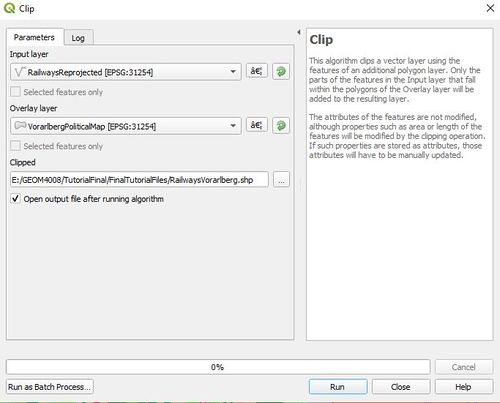

In order to find hazardous areas of concern around the rail lines, a buffer of 1000 metres was established on either side of the line. To do this, select "vector" from the top menu, then "Geoprocessing Tools" and then "Buffer".
In the Buffer window, select the RailwaysVorarlberg file as the "Input Layer", set 1000 meters under "Distance", and check off the "Dissolved result" checkbox. Leave all other parameters as default. Under "Buffered", press the ... button and select 'Save to File...". Select an appropriate filename for the buffered rail file, select .shp for the file type, and save in the appropriate directory by
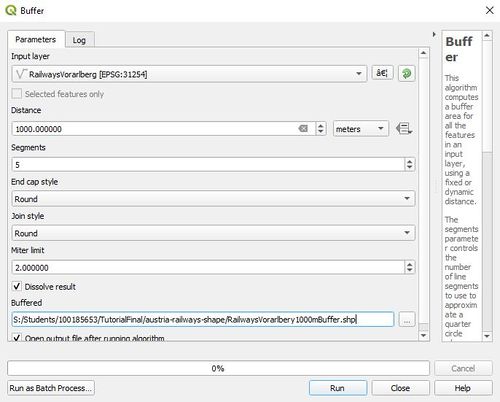
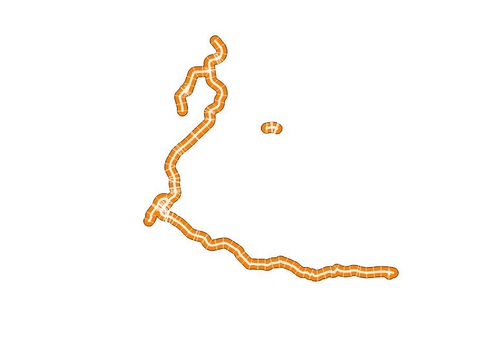
The next step is to change the colour scheme of two of the vector layers to bring out the contrasting data within the layer. The AnnualRainfallVorarlberg and GeologyVorarlberg layers will need to have their colours adjusted. To do this, highlight and right click on the layer in the “Layer Box” of the main project page, select “Properties”, and then “Symbology”. For the AnnualRainfallVorarlberg layer, select “gradient plasma” under the Favorites Box. Select “Apply” and then “Okay”. For the GeologyVorarlberg layer, complete the same procedure then select “Gradient Fill” in the top box and select “Grey” under the “color ramp”. Select “Apply” and then “Okay”.
Selection of Potentially Hazardous Areas
For each of the vector layers that define the characteristics of the Vorarlberg region, the attributes of interest that define hazardous areas must be selected. For AnnualRainfallVorarlberg, the rainfall is grouped in intervals between 1500 and 3000 mm , so the lowest three intervals were chosen: 1200-1500 mm, 1500-1800 mm and 1800-2100 mm. For GeologyVorarlberg layer, the rock types of interest were phylites, schists and sediments. For the SoilsVorarlberg layer, the soils of interest were clays (Lehm in German) and sand (Sand in German).
To select by attributes, the layer must be highlighted and right clicked in the main layer box and “Open Attribute Table” selected. Along the top of the attribute table are the headings for each column with the data in the columns below. From here, the “Select features using expression” button opens the “Select by expression” box (see below). The following expressions are entered in the left had expression box:
- AnnualRainfallVoralberg: niederschl LIKE ‘1200 – 1500 mm’ OR niederschl LIKE ‘1500 – 1800 mm’ OR niederschl LIKE ‘1800 – 2100 mm’
- GeologyVorarlberg: LEGTEXT_EN LIKE ‘%phylite%’ OR LEGTEXT_EN LIKE ‘%schist%’ OR LEGTEXT_EN LIKE ‘%sediment%’
- SoilsVorarlberg: l_bodenart LIKE ‘%Lehm%’ OR l_bodenart LIKE ‘%Sand%’
After entering the above equation in the “ Select by Expression” box, press “Select Features” at the bottom of the window and the selected features will be highlighted in the attribute table and map layer.
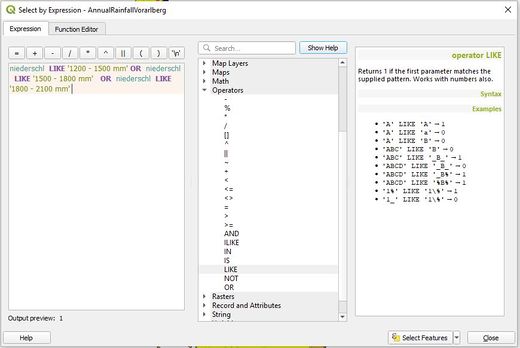
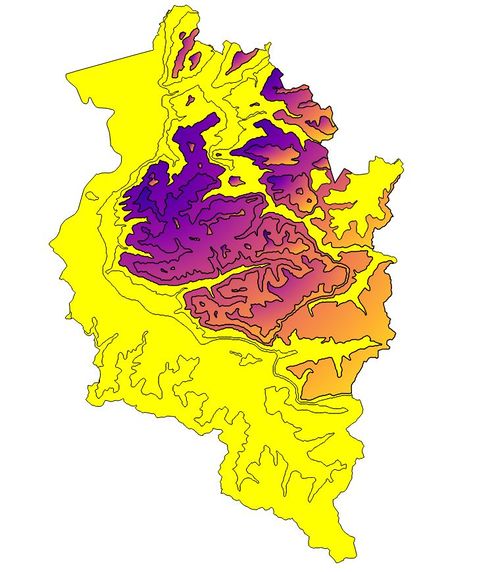
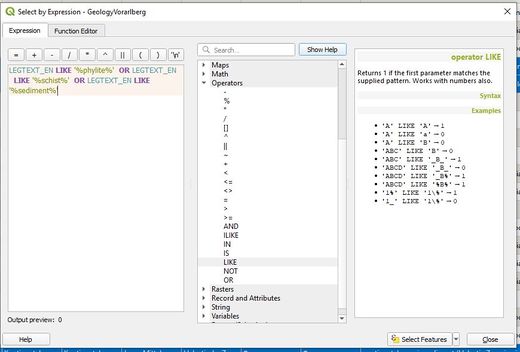
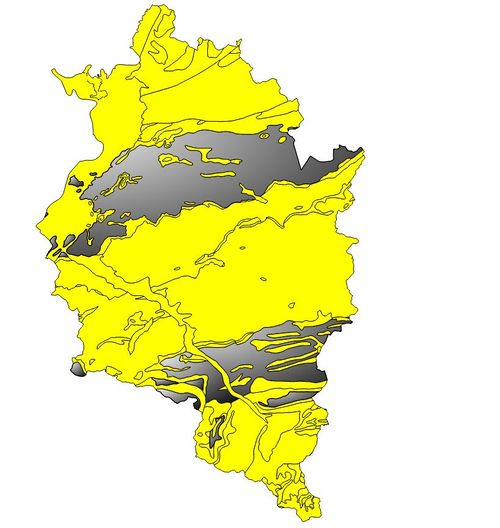
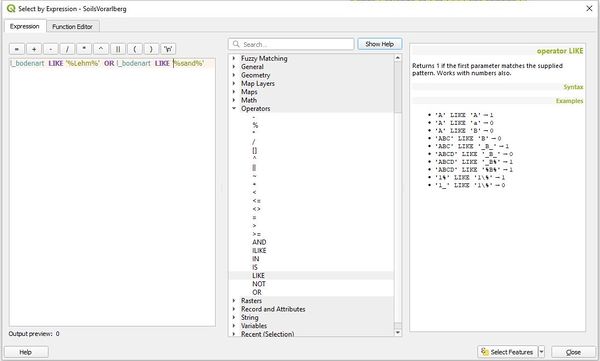
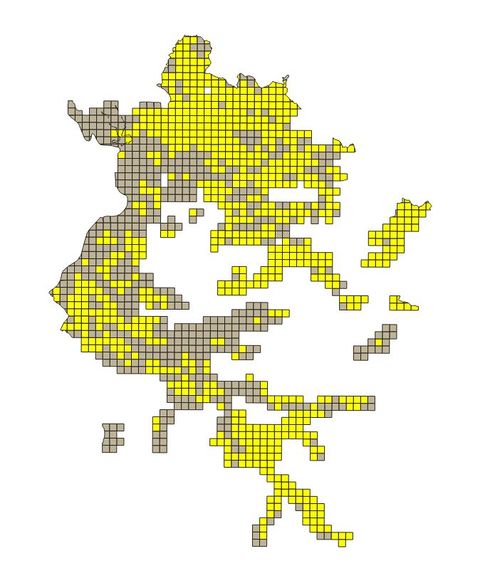
The next step is to save the selected attributes for each layer as a separate layer. Highlight the layer in the layer window, right click on it, select “Export” and “Save selected features as”. In the “Save Vector Layer as” window, set the “Format” to ESRI Shapefile, use the … button to select the project directory and give the layer a file name, and check the “Save only selected features” box. The CRS should be set to EPSG:31254 MGI/Austria GK West.
These three layers define areas of rainfall, geology and soils in Vorarlberg Land that could be potentially hazardous for linear infrastructure.
Processing of the Raster Files
In order to use the raster files, they need to have the correct projection. Both the DEM and Land Use layers have to be reprojected to EPSG:31254-MGI/Austria GK West . In order to do this for each layer,"Raster" must be selected from the top menu, "Projections" from the drop down menu, and then "Warp (Reproject)" selected.
On the "Warp (Reproject)" window, select the original vector file as the "Input Layer", select EPSG:31254-MGI/Austria GK West as the "Target CRS" and define a new file for the output under "Reprojected". Leave all other parameters at the default settings. Pressing "Run" will start the reprojection process.
The raster layers must then be clipped to the extent of Vorarlberg Land. To accomplish this, "Raster" must be selected from the top menu and "Extraction" from the drop down menu.
For the Reprojected DEM file, "Clip Raster by Mask Layer" should the be selected. The "Input layer" is the DEMReprojected raster layer, and the "Mask Layer" is the Vorarlberg Political Map layer. Under "Advanced Parameters", a new file is defined for the clipped DEM layer under "Clipped (mask)"in an appropriate file directory.
For the Land Use layer, "Raster" is selected from the top menu, then "Extraction" from the drop down menu, then "Clip Raster by Extent". On the Clip Raster by Extent window, the LandUseReprojected raster file is selected for "Input Layer" and the Vorarlbeg Political Map layer as the clipping extent. This is done by pressing the small...button at the end of the "Clipping extent (xmin,xmax,ymin, ymax) option, then selecting "Use Layer Extent" and then selecting VorarlbergPoliticalMap under "Use extent from". Under "Advanced Parameters" name a new file for the clipped Land Use raster in an appropriate file directory.
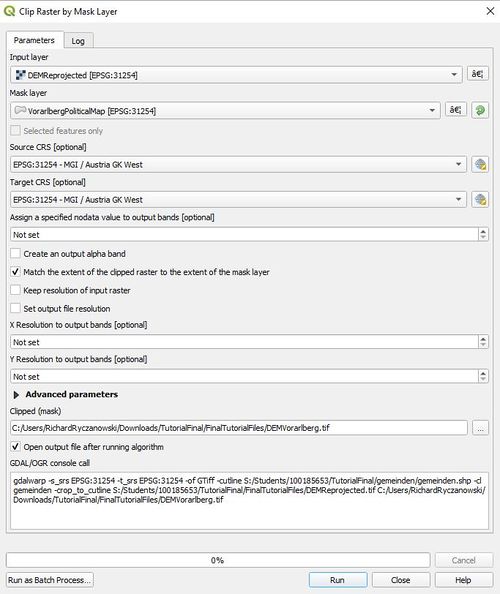
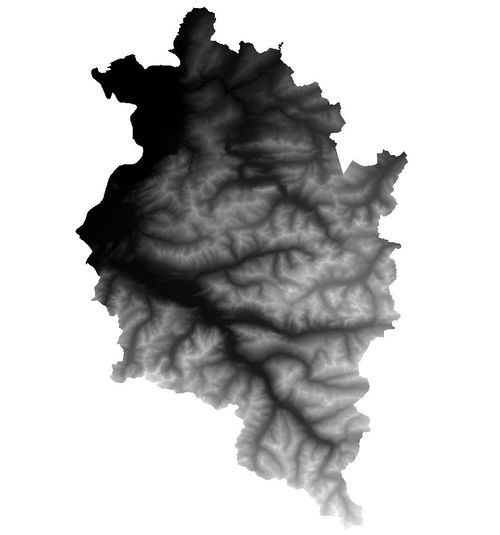
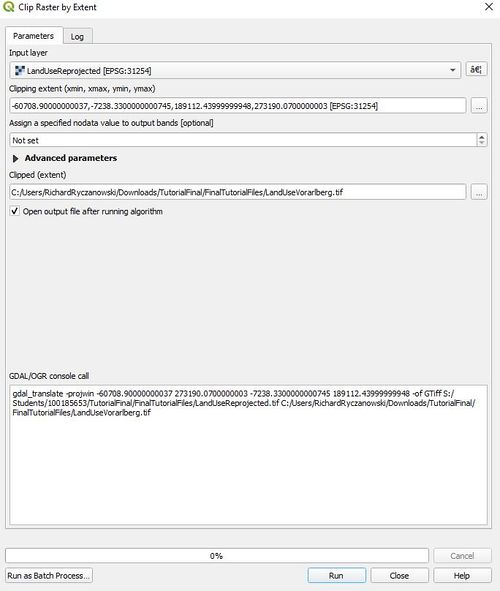
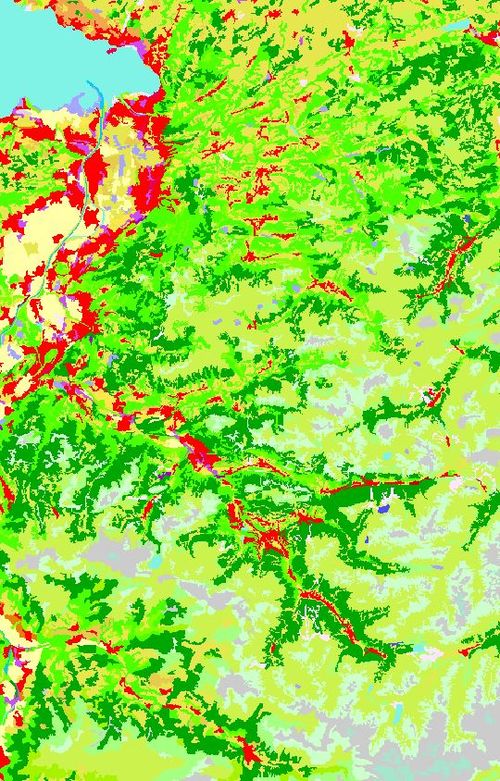
To identify the land use/cover classes in the land use layer, the legend will have to be added to the layer. The legend can be found in the "Legend"directory of the unzipped land use data. To add the legend, select the LandUseVorarlberg layer in the "Layers" window of the main page, right click on it, select "Properties", then select "Symbology",
Look for the small button to the right of the "Delete All" button. Press the button, select "Load colour map from file", and add the CLC2018+CLC2018_V2018_20_QGIS text file from the "Legend" directory of the unzipped land use data. This will add the legend information under the land use layer in the main "Layer"window.
In order to find areas with hazardous slopes, the DEM layer will have to be converted into a slope layer. To do this, "Raster" is selected from the top menu, then "Analysis" from the drop down menu, then "Slope".
The DEM Vorarlberg layer is selected as the "Input layer" and under "Advance Parameters" and "Slope" specify a filename for the new slope layer in the appropriate project directory. Leave all other parameters at their default settings.


The next step is to identify those areas of slope and land use/cover that could be potentially hazardous. For the slope, those above 25 degrees are considered to be potentially hazardous. For land use/cover, potentially hazardous areas are bare rock (332) or sparsely vegetated land (333). In order to select these area from the relevant raster layer, the raster calculator will be used. The Raster Calculator can be found under "Raster" on the main menu at the top.
On the raster Calculator window for the slope layer, under "Raster Bands" select the SlopeVorarlberg layer. Under "Output Layer", select a name for the new layer file for the selected areas in the appropriate directory. In the "Raster Calculator Expression" window, double click on the SlopeVorarlberg layer in the "Raster Bands" box and the operator buttons to enter the following equation:
"SlopeVorarlberg@1" > 25
Then press okay to start the selection operation.
For the Land Use layer, under "Raster Bands" in the "Raster Calculator" window, select the LandUseVorarlberg layer. Under "Output Layer", select a name for the new layer file for the selected areas in the appropriate directory. In the "Raster Calculator Expression" window, use double clicks on the LandUseVorarlberg layer in the "Raster Bands" box and the operator buttons to enter the following equation:
"LandUseVorarlberg@1" = 332 OR "LandUseVorarlberg@1" = 333
Then press okay to start the selection operation.

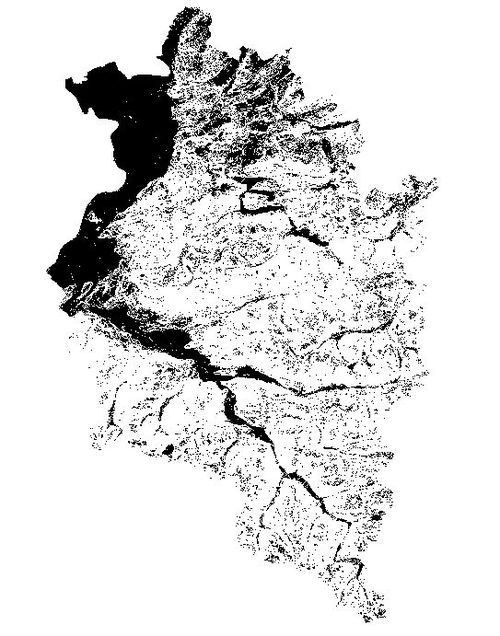
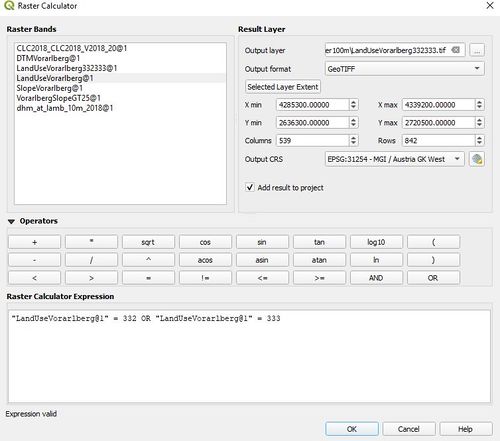

In both layers, the white areas are the ones that are potentially hazardous.
In order to further utilize the slope and land use raster layers with the selected areas, they must be converted into vector layers. To do this, the procedure is the same for both layers. Select "Raster" on the main menu at the top, then "Conversion" on the drop down menu, then "Polygonize (Raster to Vector)'. For the SlopeVorarlbergGT25 layer, select that file as the "Input layer", then, under "Vectorized", input a file name for the new VorarlbergSlopeGT25 layer in the appropriate project directory. Press Run to start the conversion process. The process is the same for the Land Use layer.
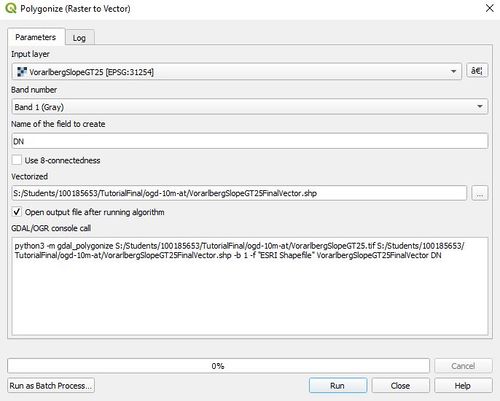
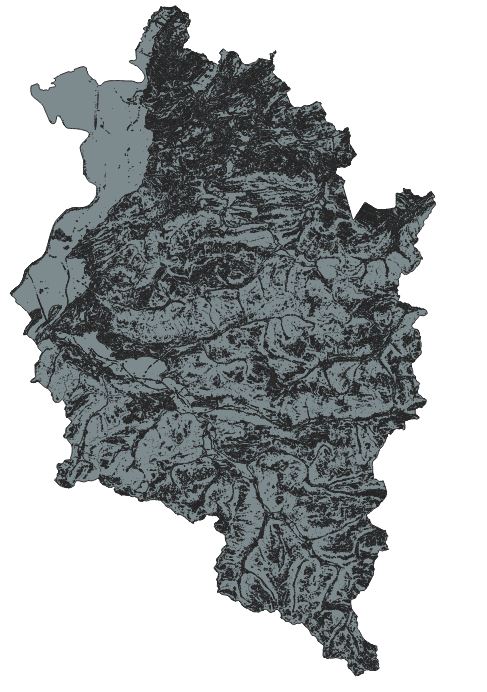

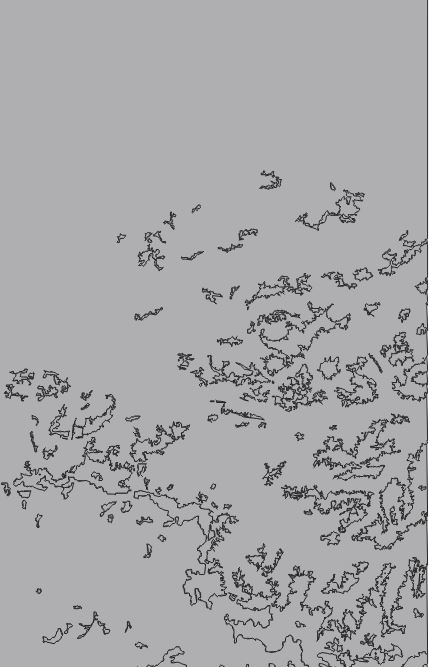
Unfortunately, the vectored layer output for both layers have an invalid geometry. To correct this problem, and make the layers usable for the rest of the analysis, a new vector layer must be created for each original layer with a buffer of zero. The procedure to do this for both layers is the same. Select "Vector" from the main menu at the top, then "Geoprocessing tools" and then "Buffer". For the slope vector, select the SlopeVoralbergGT25FinalVector layer as the "Input layer" in the Buffer window, set the "Distance" to zero, and select a file name and directory for the new SlopeGT25VectorBuffered layer under "Buffered" and place in the appropriate directory. Leave all the other settings at their default. Press Run to start the buffering process. The procedure is the same for the land use layer using the LandUse332333 vector file.
Intersecting the Layers
The final stage of this analysis is to intersect the five layers that have been used to define potentially hazardous areas (based on Annual Rainfall, Geology, Soils, Land Use and Slope)to determine the final area where the characteristics combine to make the area a combined hazardous area. To do this, a series of intersection operations are performed:
Annual Rainfall intersects with Geology to give AnnualRainfallGeologyIntersection AnnualRainfallGeology intersects with Soils to give AnnualRainfallGeologySoilsIntersection AnnualRainfallGeologySoils intersects with Land Use to give AnnualRainfallGeologySoilsLandUseIntersection AnnualRainfallGeologySoilsLandUse intersects with Slope to give AnnualRainfallGeologySoilsLandUseSlopeIntersection
To give the final combined hazardous areas within the 1000 metre railway buffer:
AnnualRainfallGeologySoilsLandUseSlope intersects with Rail Buffer to give AnnualRainfallGeologySoilsLandUseSlopeRailBufferIntersection
To create the intersection layers, select "Vector" from the top menu, then "Geoprocessing Tools" and then "Intersection".
In the intersection window, under "Input Layer" select the first of the two layers that are to be intersected. In the "Overlay layer", select the second layer that is to be intersected. Under "Advanced Parameters", a new filename is entered for the new intersection file that is saved in the appropriate project directory. Leave all other options at their default settings. Pressing "Run" starts the intersection process. The Intersection Window for each of the five intersections are shown below with their output layers.
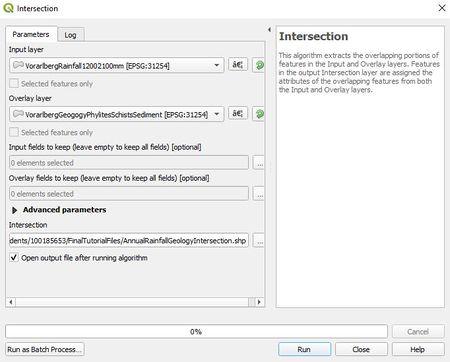

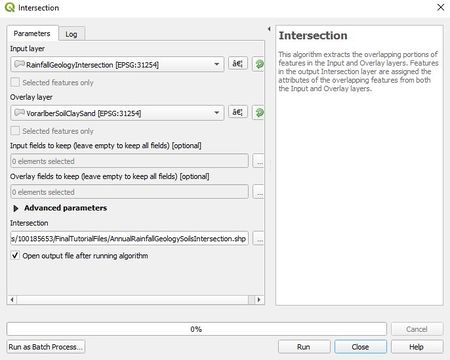
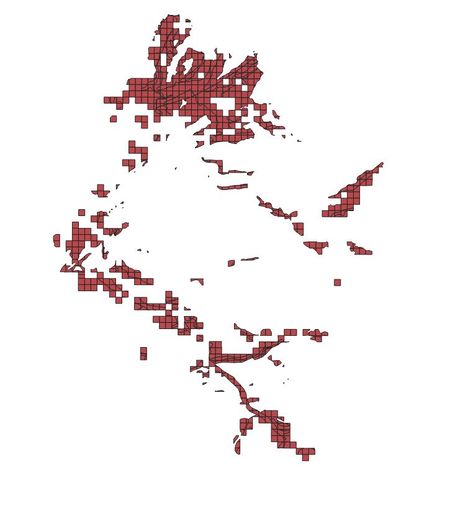
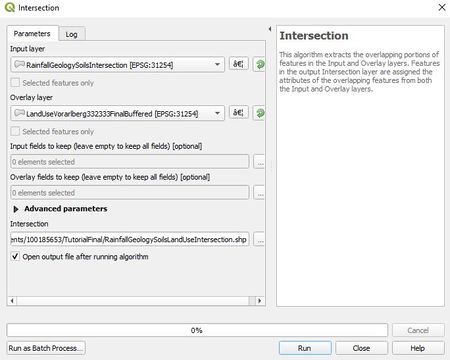
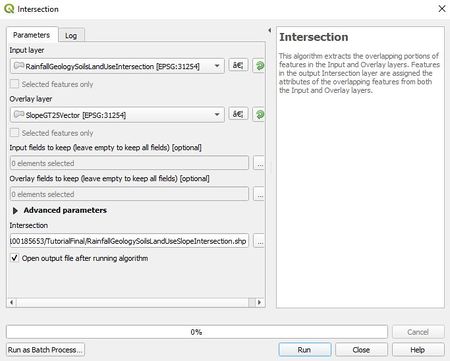
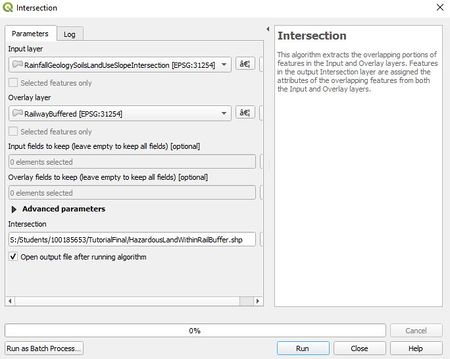
Final Maps
Here are the final maps showing the hazardous areas of concern for mass movements along railway lines in Vorarlberg region. These are areas where mean annual rainfall, soils, geology,land use and slope with characteristics that are prone to mass movements overlap.

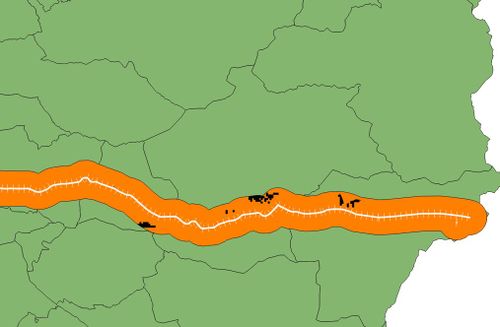
References
Laimer. H. 2017. Anthropogenically induced landslides – A challenge for railway infrastructure in mountainous regions. Engineering Geology. 222:92-101.
Peruccacci, S., M. Brunetti, S. Gariano, M. Melillo, M. Rossi, and F. Guzzetti (2017). Rainfall thresholds for possible landslide occurrence in Italy. Geomorphology 290: 39-57.
Rachoy C. and M. Scheikl (2006). Anthropogenic caused mass movements and their impact on railway lines in Austria. Pages 639 – 643 in H. Mauri and M. Mikos, editors. Disaster mitigation of debris flow, slope failures and landslides. Universal Academy Press, Tokyo, Japan.
